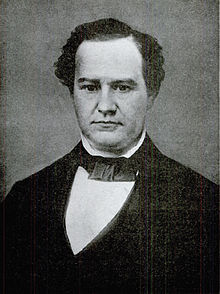George D. Prentice
George D. Prentice | |
|---|---|
 | |
| Born | December 18, 1802 |
| Died | January 22, 1870 |
| Cause of death | Influenza |
| Occupation | Newspaper Editor |
| Political party | Whig |
George Dennison Prentice was the editor of the Louisville Journal, which he built into a major newspaper in Louisville, Kentucky. He attracted readers by satire as well as exaggerated reporting and support of the Know-Nothing Party in the 1850s. His writing was said to contribute to rabid anti-Catholic and anti-foreigner sentiment, and a riot in 1855. During the Civil War, he created and wrote about a fictional guerrilla "Sue Mundy", whose activities he used to taunt the Union military commander of the state.
Biography
The son of a farmer, Prentice excelled in school and graduated from Brown University in 1823. Following graduation he began contributing to literary periodicals and studied law in Canterbury, Connecticut. Although he joined the bar in that state, he was more interested in literature. After practicing law briefly, he became editor of the Hartford New England Review in 1828.
On the strength of his political writings, he was invited to come to Kentucky to write a campaign biography of Henry Clay, which sold 20,000 copies. Prentice received no money for this work because the publisher went bankrupt. He stayed in Louisville and accepted an offer to co-found the Louisville Journal newspaper in 1830, with the goal of rivaling the then-dominant Louisville Public Advertiser. Prentice soon found himself in an editorial feud with Advertiser publisher Shadrack Penn, which continued until Penn left the city in 1841.
The Journal quickly became popular in Louisville, largely because of Prentice's biting editorials and the savage wit of his replies to detractors. Prentice was a dedicated backer of the Whig Party. In the 1850s, Prentice editorialized in support of the Know-Nothing party and the pro-slavery, anti-Catholic and anti-foreigner movement that reached a hysterical level in the 1850s in many parts of the nation.
In Louisville this culminated in the Bloody Monday riot of 1855, in which 22 people were killed. Just days before the riots, which occurred as mobs tried to prevent Irish and German citizens from voting on election day, Prentice had editorialized against the "most pestilent influence of the foreign swarms" loyal to a pope he called "an inflated Italian despot who keeps people kissing his toes all day." According to Archbishop John Lancaster Spalding, Prentice later publicly expressed regret over his role in the riots.[1]
Prentice supported the Union in the 1850s, but disagreed with many of its policies during the Civil War. In 1861 he joined a group that urged Kentucky not to secede from the Union but establish itself as a neutral party in the war. In 1864 he created the famous "Sue Mundy" guerrilla character to mock the incompetence of Union General Stephen G. Burbridge, military commander of Kentucky.[2]
After the war Prentice opposed many of the policies of Reconstruction. His paper was one of the few that criticized federal rebuilding policies of the time. Prentice remained as editor of the paper during and after the 1868 merger that created The Courier-Journal.
He died of influenza and was buried in Cave Hill Cemetery.
Legacy
His legacy is generally unfavorable, with an editor from his own paper calling Prentice's writings "raw bigotry" in a 1993 feature on the history of the newspaper. A statue of Prentice by Alex Bouly, was completed in 1875. It was originally displayed at the Courier-Journal building in Louisville, Kentucky, but was moved in 1914 to its present location in front of the Louisville Free Public Library's main branch. It has been a source of occasional controversy, due to Prentice's famous anti-Catholic and anti-immigrant rhetoric. A compromise reached at one point involved the city placing a new plaque for the statue, describing Prentice's "tarnished legacy".[1]
A Liberty ship, the SS George D. Prentice, was launched in 1943 and remained in service until 1969.
See also
Notes
- ^ a b Smith, Peter (2005-07-30). "Recalling Bloody Monday". The Courier-Journal.
{{cite news}}: Italic or bold markup not allowed in:|publisher=(help) - ^ Egerton, Judith (2006-05-22). "'She Devil' recalls bloody past". The Courier-Journal.
{{cite news}}: Italic or bold markup not allowed in:|publisher=(help)
References
- "Prentice, George Dennison". Encyclopedia of Louisville. 2001.
- Congleton, Betty Carolyn (April 1967). "George D. Prentice: 19th Century Southern Editor". Register of the Kentucky Historical Society. 65: 94–119.
- Congleton, Betty Carolyn. "George D. Prentice and Bloody Monday: A Reappraisal," Register of the Kentucky Historical Society, 65 (1965) pp 220–39
External links
- 1802 births
- 1870 deaths
- People from New London County, Connecticut
- Louisville, Kentucky in the American Civil War
- American newspaper editors
- People from Louisville, Kentucky
- People of Kentucky in the American Civil War
- Burials at Cave Hill Cemetery
- People from Preston, Connecticut
- Kentucky Know Nothings
- Kentucky Whigs
- 19th-century American politicians
- Deaths from influenza
- Infectious disease deaths in Kentucky
- 19th-century American journalists
- American male journalists
- 19th-century male writers
